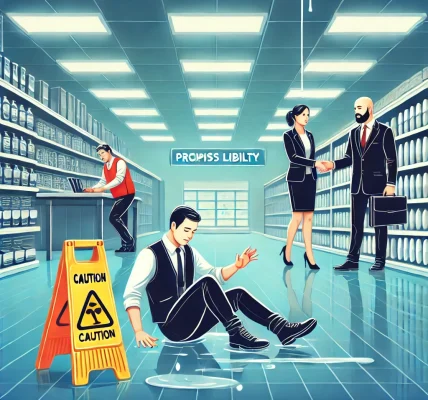Introduction
When filing a personal injury claim, proving negligence is the key to securing compensation. Negligence occurs when a person or entity fails to exercise reasonable care, leading to injury or harm to another party. To successfully win a personal injury lawsuit, the plaintiff must establish that the defendant’s actions (or inactions) directly caused their injuries.
This comprehensive guide will explore the essential elements of proving negligence, the types of evidence required, and strategies to strengthen your case while ensuring legal accuracy and protection.
What is Negligence in a Personal Injury Claim?
Negligence in personal injury law refers to the failure of an individual or organization to act with reasonable care, resulting in harm to another party. This concept applies to various types of accidents, including car crashes, slip and fall incidents, medical malpractice, and workplace injuries.
To hold someone legally responsible, the plaintiff must prove that the defendant’s negligence caused the injury. However, proving negligence is not always straightforward, as the defense may argue that other factors contributed to the incident.
The Four Elements of Negligence
To establish a negligence claim, the plaintiff must prove four essential elements:
1. Duty of Care
The plaintiff must show that the defendant owed them a legal duty of care. Duty of care refers to the responsibility to avoid actions (or inactions) that could cause harm to others.
- Example: Drivers have a duty to follow traffic laws and drive safely.
- Example: Property owners have a duty to maintain safe premises for visitors.
2. Breach of Duty
A breach occurs when the defendant fails to meet the expected standard of care. The plaintiff must demonstrate that the defendant’s actions deviated from what a reasonable person would do in a similar situation.
- Example: A doctor failing to diagnose a serious condition that another competent doctor would have detected.
- Example: A store owner ignoring a wet floor hazard, leading to a slip and fall accident.
3. Causation
The plaintiff must prove that the defendant’s breach of duty directly caused their injuries. This is often divided into two subcategories:
- Actual Cause: Also known as “cause-in-fact,” it means that the injury would not have happened if not for the defendant’s negligence.
- Proximate Cause: This ensures that the defendant is only responsible for foreseeable consequences of their actions.
- Example: A distracted driver running a red light and hitting a pedestrian—this is a direct and foreseeable consequence.
4. Damages
Finally, the plaintiff must provide evidence of actual damages suffered due to the negligence. This includes:
- Medical expenses (hospital bills, therapy, prescriptions)
- Lost wages (missed work due to injuries)
- Pain and suffering (emotional distress, physical pain)
- Property damage (vehicle repairs after a car accident)
Without provable damages, even a strong negligence claim may fail in court.
Types of Evidence to Prove Negligence
A strong personal injury case relies on compelling evidence. The following types of evidence help establish the four elements of negligence:
1. Medical Records
- Show the extent of injuries.
- Link injuries to the accident.
- Indicate long-term effects and necessary treatments.
2. Witness Statements
- Testimonies from people who saw the incident unfold.
- Help corroborate the plaintiff’s account of events.
3. Accident Reports
- Police reports in car accidents.
- Workplace incident reports.
- Store records in slip and fall cases.
4. Photographs & Videos
- Scene of the accident (skid marks, broken steps, hazardous conditions).
- Injuries sustained (bruises, fractures, scars).
- Surveillance footage capturing the event.
5. Expert Testimonies
- Medical experts explaining the severity of injuries.
- Accident reconstruction experts analyzing how the incident occurred.
- Engineers or safety specialists evaluating hazardous conditions.
6. Employment & Wage Records
- Necessary to claim lost wages.
- Demonstrates financial impact due to the injury.
Steps to Strengthen a Negligence Claim
Successfully proving negligence requires a strategic approach. Here are key steps to strengthen your personal injury case:
1. Seek Immediate Medical Attention
- Medical records serve as crucial evidence.
- Delaying treatment can weaken the claim.
2. Preserve All Evidence
- Take photos and videos of the accident scene.
- Save medical bills and insurance statements.
3. Avoid Giving Recorded Statements to Insurance Companies
- Insurance adjusters may twist words to minimize payouts.
- Consult an attorney before making official statements.
4. Hire a Personal Injury Attorney
- A skilled lawyer can gather evidence, negotiate settlements, and represent in court.
- Attorneys help avoid legal pitfalls and protect clients’ rights.
5. Document Everything
- Keep a detailed journal of medical treatments and pain levels.
- Maintain communication records with insurance companies and healthcare providers.
6. Be Cautious with Social Media
- Avoid posting details about the accident or injuries.
- Insurance companies monitor social media for evidence to dispute claims.
Common Defenses Against Negligence Claims
Defendants often use the following defenses to challenge negligence claims:
1. Comparative Negligence
- The plaintiff is partly at fault, reducing their compensation.
- Example: A pedestrian jaywalking when hit by a speeding driver.
2. Assumption of Risk
- The plaintiff knowingly engaged in a risky activity.
- Example: A skier gets injured in an area marked for hazardous conditions.
3. Lack of Causation
- The defendant argues that the injury was not caused by their actions.
- Example: A patient claiming malpractice but already had a pre-existing condition.
4. No Actual Damages
- The defendant argues that the plaintiff did not suffer real harm.
- Example: Minor fender bender where no medical treatment was required.
Conclusion
Proving negligence in a personal injury claim is essential for securing compensation. By establishing duty of care, breach of duty, causation, and damages, plaintiffs can build a strong case. Gathering solid evidence, working with experienced attorneys, and understanding potential defenses can increase the likelihood of a favorable outcome.
If you have been injured due to someone else’s negligence, taking the right legal steps can help you receive the justice and compensation you deserve. Always consult a personal injury attorney to ensure your rights are protected throughout the claims process.




